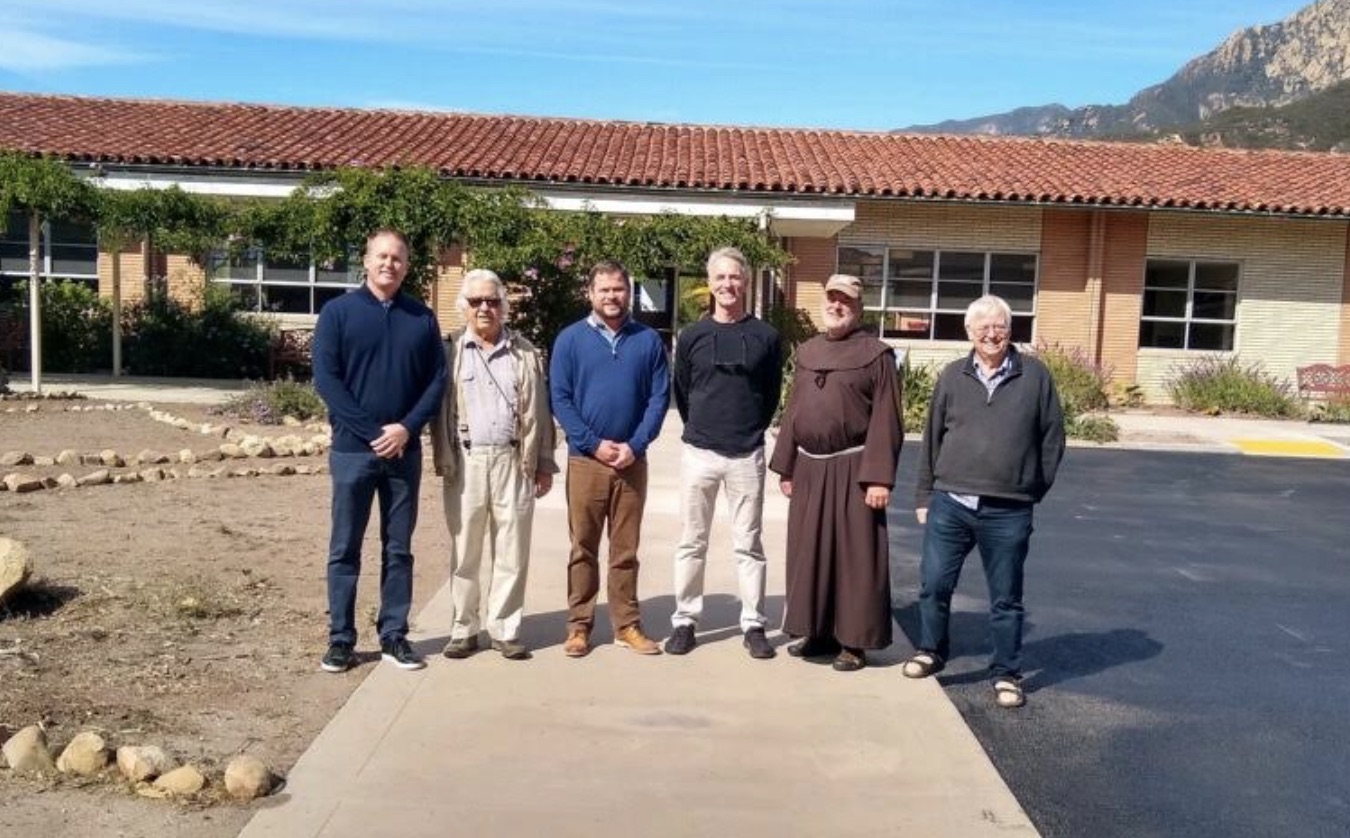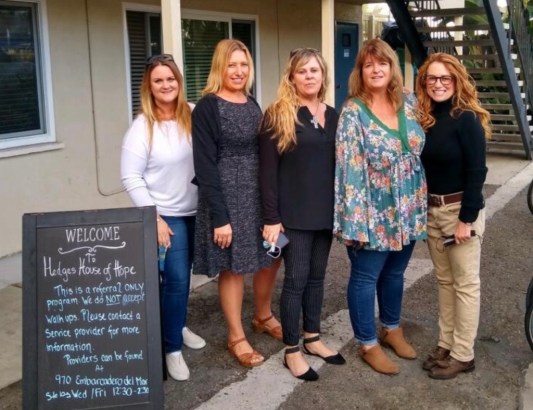Can St. Mary’s Help the Homeless Crisis?

“Sometimes,” said Santa Barbara Sheriff Bill Brown, “you see a moose.”
This folksy Zen aphorism dates way back to Brown’s days as chief of police in Moscow, Idaho. A consultant Brown had hired at the time recounted how one morning, his kids announced that three moose were grazing in the family’s backyard. The consultant, Brown said, would be late for work that day. His kids would be late for school. They all just sat and stared at the moose. What else could they have done?
The “moose” in the room to which Sheriff Brown now alludes is a wild-assed, creative, sure-to-be-controversial proposal hatched by downtown real estate investor Richard Berti to “buy” the long-vacant St. Mary’s Seminary. He had first unveiled the plan three weeks ago with the sudden abruptness of an impatient man on a mission, which is exactly what Richard Berti is.
Located off the steep and winding switchbacks of Las Canoas Road, Berti proposed to dedicate the property — the seminary itself is 55,000 square feet; the land involved is 35 acres — to the treatment and care of homeless people. “Nobody saw this coming,” Brown acknowledged. “It was straight out of left field.”
Early Monday afternoon, Brown had convened a two-hour Zoom fest attended by a host of movers and shakers to discuss the possibilities of Berti’s idea and hear the pros and cons. Immediate neighbors of St. Mary’s called the plan a significant fire hazard in an already high-fire area.
However, lending credibility to the proposal — somewhat reluctantly and heavily qualified — was a commitment from the County of Santa Barbara to kick in $1 million to buy the property. The asking price is $14 million.
Berti’s proposal comes at a time when the unholy trinity of homelessness, mental illness, and drug addiction is galloping throughout the nation. With Joe Biden in the White House and Democrats “controlling” Congress, billions of dollars are now being allocated to address the humanitarian crisis. Of the $86 million in American Rescue Plan Act dollars now slated for the County of Santa Barbara, supervisors committed — just last week — to spend $28 million on homeless services and infrastructure.
That same week, the supervisors were told that the number of unsheltered homeless people in Santa Barbara County — these are individuals who bed down outside or in cars — increased by 34 percent since the pandemic started.
Other Ideas Heard From

From that pool of county money, $7 million is going to purchase a former sorority house on El Colegio Road in Isla Vista that’s been offering up to 50 structured beds a night to chronically homeless people since July. Most of the residents of what’s called the Hedges Halfway House — named after the now deceased, longtime homeless advocate Father John Hedges — evolved from a cluster of 20 pallet homes that had been parked last December between the sprawling chaos of People’s Park and the Isla Vista Community Service District and removed in June.
Managing both the pallet homes and the Hedges House of Hope is Sylvia Barnard, whose Good Samaritan Shelter nonprofit — based in Santa Maria — now operates 500 shelter beds in 30 locations, all with remarkably little to no drama. Roughly 70 percent of the House’s new residents are wrestling with severe addiction, heroin being the most common.
To date, there have been no calls for service.
Barnard and Good Sam are also slated to assume management of what’s called the DignityMoves tiny homes project slated to open on Garden Street early this January. And just last week, the Santa Barbara City Council voted to spend an additional $1.2 million to extend the lease for all the rooms in San Roque’s Rose Garden Inn motel for homeless guests displaced when six high-fire-risk encampments were shut down.
That brings the total spent for this motel to $2.8 million. Presumably, many guests at the Rose Garden Inn — a city project — will transition to the new DignityMoves tiny homes — a county project — though negotiations are still being hammered out. Good Samaritan — which, among many other things, happens to run the largest drug and alcohol rehab operation in the county — will also manage DignityMoves.
The point of this recitation is that a lot’s been happening — or is about to — even though for many people, it doesn’t seem that way. The campaign rhetoric surrounding homelessness in the current City Council election sounds exactly like what voters heard 30 years ago.
Pie in the Sky?
In this context, Richard Berti’s proposal hit like a cross between a Molotov cocktail and a Hail Mary pass. In the halls of government, however, the fear is that his proposal is both a white elephant — probably half the property would need to be retrofitted to comply with the Americans with Disabilities Act — and a red herring. Skeptics suggest it’s just a way for downtown property owners to get homeless people off State Street and get them somewhere else.
Berti — in his mid-eighties and still a bull in a china shop — announced he’d written a refundable check for $435,000 to tie up the St. Mary’s seminary in escrow for 45 days. It all depends on local governments expressing serious interest in buying the seminary and installing an operator who could do the job.
Berti said he’s taken a lot of grief: “I’m just trying to get something done. I want a place to happen where people can get help.” In the intervening time, he has been leading tours to the site in hopes of encouraging city councilmembers, county supervisors, private philanthropists, and other businesspeople.

It’s impossible not to be swept up by the possibility of the place. A seminary for Vincentian brothers from the early 1960s until about 10 years ago, St. Mary’s offers nearly wrap-around mountain views accompanied by an enveloping silence. Just by being there, one can achieve a meditative state. There are dorm rooms, indoor and outdoor common areas, a commercial-grade kitchen, a gymnasium with a professional basketball court, and a chapel with 40-foot-high ceilings.
And it’s all just sitting there, doing nothing.
Currently, the property is owned by Revere Capital, which obtained it by foreclosure shortly after the city Planning Commission granted a conditional-use permit in 2016 allowing a residential drug and alcohol treatment center on the site. Neighbors were not thrilled with that plan either.
For whatever reason, however, the rehab project never got off the ground. Since then, the property has been used for assorted spiritual retreats and overnight school field trips. The owner is just now putting the finishing touches on a major renovation effort, getting half the site ADA-compliant and repaving much of the driveway.
A year ago the County of Santa Barbara checked out the property as a possible homeless shelter and passed: It’s too far from where homeless people are, and too far from service providers. With no bus lines, how would people get there? In competing for potential grants funding, that lack of transit access would hurt the county’s chances. Without grants, who would pay for the services? More problematic, what would happen if clients wandered off? What if there was a fire? Worse yet, what if the clients started the fire? And none of that addresses whatever unfinished repairs still need to be done.
Hope Is Eternal
Trying to sort out what, if anything, is possible is the responsibility of the Scoping Committee created during Sheriff Brown’s Monday Zoom meeting. Heading that committee is none other than Sylvia Barnard, CEO of Good Samaritan.
Barnard and Good Sam enjoy an almost walk-on-water reputation: They know how to run shelters effectively, compassionately, and with little friction with neighbors. Services are provided. Focused case management is pursued. Rules are enforced: no visitors allowed, 10 p.m. curfews, no drugs or booze allowed. Rooms are searched. Chores are required. Security is round-the-clock.
Barnard has toured St. Mary’s and thinks it has huge potential for a residential treatment for those recovering from drug or alcohol addiction. In the South Coast, the need for such a facility is pressing. Ninety-day stays, Barnard said, tend to get the best results.
It will fall to her and the scoping committee to figure out which programs might be best suited to the site and what licenses would be required. It would fall to Berti — as chair of the finance committee — to figure out how to raise the funds. And the administrative committee will have to figure out how to sustain ongoing programs. It’s anything but simple.
In the meantime, Berti said he intends to ask Revere Capital to extend escrow on the property. “We need to squeeze the cantaloupe some more,” he said. If he doesn’t get it, the deal’s off. If he does, the various committees Sheriff Brown assigned can determine whether the site is programmatically and financially viable and how neighbors’ concerns can be addressed. Berti’s also giving serious thought to starting a new nonprofit to raise the funds to purchase the property outright.
“It’s getting more complicated, floating around and a lot of questions,” he said. “I just wanted to do something simple.”
The whole thing, acknowledged Brown, might turn out to be “a flash in the pan.” But maybe not. The possibilities seem enormous. “If it fails, it fails. At least we will have tried,” he said. In very short order, the proposal has generated considerable buzz, consternation, opposition, and collaborative excitement. Something good, Brown said, has to come from all that. “Sometimes you see a moose.”
The writer of this article has done freelance writing for Richard Berti.
Support the Santa Barbara Independent through a long-term or a single contribution.




You must be logged in to post a comment.